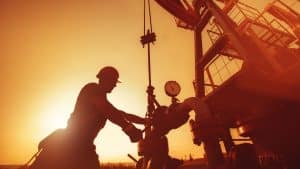Understanding the Severity of “Caught in or Between Objects” Accidents
 North Dakota is home to many oil field employees, construction workers, and farmers – people who contribute to the strength and infrastructure of our country. Even though their job duties vary across industries, one thing all these workers have in common are the risks they take on the job. The Occupational Safety and Health Administration (OSHA) actually keeps a list of what they call the “Fatal Four,” which are the four leading causes of worker fatalities.
North Dakota is home to many oil field employees, construction workers, and farmers – people who contribute to the strength and infrastructure of our country. Even though their job duties vary across industries, one thing all these workers have in common are the risks they take on the job. The Occupational Safety and Health Administration (OSHA) actually keeps a list of what they call the “Fatal Four,” which are the four leading causes of worker fatalities.
OSHA’s Fatal Four (excluding things like motor vehicle accidents) include falls, electrocutions, being struck by objects, and being caught in or caught between objects. In today’s blog, we want to focus on the last one – “caught in or between objects.” This is an extremely serious event that often leads to traumatic or fatal injuries.
The Bureau of Labor & Statistics (BLS) reports that, in 2020, there were 4,764 fatal work injuries recorded in the United States. Out of these deaths, 142 fatalities were attributed to “caught in or compressed by equipment or objects.” Eighty-nine of them occurred from “caught in running equipment or machinery” and 93 were caused by “struck, caught, or crushed in collapsing structure, equipment, or material.”
There are several types of “caught in or between objects” accidents.
- Machines with unguarded moving parts – these can include tools and machinery with open blades (like brush hogs) or machines that tip over (like bulldozers).
- Pinned in between – when a worker is pinned between pieces of heavy equipment, between a piece of equipment and a wall, or between materials.
- Buried in or by – this typically happens during cave-ins of trenches or excavations without proper support.
Per EHS Today, the second-leading cause of oil and gas industry fatalities are “struck-by / caught-in / caught-in between accidents, which are responsible for three out of every five on-site fatalities.” Only transportation-related accidents cause more deaths in the industry.
What kinds of injuries happen from caught in or between object accidents?
These types of accidents, as you can see, can cause catastrophic injuries. Some of these include:
- Crushed, broken and fractured bones
- Injuries to soft tissues, ligaments, and muscles
- Traumatic brain injuries
- Internal bleeding
- Traumatic amputation and loss of limb
- Lacerations and cuts
- Internal organ damage
- Spinal cord injuries
- Wrongful death
Long-term repercussions of a caught-in or caught-between accident
In a worst-case scenario, a person can die – either at the scene or shortly thereafter – as a result of a caught between or caught in accident. But if a person does survive, there are serious complications that can arise during the recovery period.
Muscle and neurogenic atrophy
Say you break your leg, and the doctor says it’ll take about 4 months for it to fully heal. For those four months, you can kind of function normally, meaning you can get around okay with crutches or a cane, and you don’t mind riding a desk for a while until you can get back out in the field (either literally or figuratively). But during those four months, the muscles in your leg will weaken, and you’ll likely need some kind of PT to get yourself back in shape. It’s inconvenient and painful, but you know you’ll be okay.
But a broken leg and a shattered pelvis are two very different injuries, and the recovery time is vastly different. Not only could it take years for you to recover, but the muscle atrophy can prove permanent. If your nerves were severed as a result of being caught and crushed, you could permanently lose the ability to walk unassisted. This is called neurogenic atrophy, and it will last the rest of your life. Depending on the exact nature of the injury, it can also shorten your lifespan.
Organ transplants
Internal injury is a common result of caught in or between object accidents. In some cases, the crushing aspect of these incidents can cause permanent organ damage, which could necessitate an organ transplant. Aside from the urgency that arises from any type of organ damage (potential infection, possible failure, the very good chance the injury could be fatal) and the complexities of finding a proper match, you also have long wait times when you’re on the transplant list. According to the Gift of Life Donor Program, the average wait times include:
- Kidney – 5 years
- Liver – 11 months
- Heart – 4 months
- Lung – 4 months
- Kidney / Pancreas – 1.5 years
- Pancreas – 2 years
All of this assumes, too, that you are deemed an acceptable recipient. If you have an underlying medical condition that leaves you unable to care for yourself, you could be disqualified. Certain diseases, like cancer or addiction, can also disqualify you.
Post-traumatic stress disorder
Just as common, though perhaps less often discussed, is the long-term emotional, psychological, and mental trauma you can sustain from a catastrophic injury. Post-traumatic stress disorder (PTSD) is well-documented in vehicle accident victims (though the most recent study of PTSD from work-related trauma is nearly 25 years old, it appears); the same criteria often applies to people who have undergone other types of physical trauma. A person who is caught in a machine or in a trench collapse may relive that feeling of being trapped for months or years – possible even forever. According to the National Center for PTSD:
- About 6 out of every 100 people (or 6% of the population) will have PTSD at some point in their lives.
- About 12 million adults in the U.S. have PTSD during a given year. This is only a small portion of those who have gone through a trauma.
- About 8 of every 100 women (or 8%) develop PTSD sometime in their lives compared with about 4 of every 100 men (or 4%).
PTSD can make it almost impossible to hold down a job or resume relationships with family and friends. It can affect your physical health as well, and increase the risk of substance abuse, self-harm, and suicidal thoughts. You can also suffer PTSD even if you weren’t critically injured at the time of the accident.
The thing about caught in or between objects injuries is that they pose a real risk of long-term complications and conditions, and treatment may be ongoing for the rest of your life. You may be left unable to work or care for yourself or your family. This is why you want a Minot personal injury lawyer on your side if you are offered a settlement; it may simply not be enough to cover your medical expenses and lost wages, let alone your pain and suffering, for the long term.
Let Larson Law help protect your rights after you’re injured. With offices in Minot, Bismarck, and Fargo, we help folks all throughout North Dakota when they suffer severe injuries through no fault of their own. Don’t talk to the insurance companies without talking to us first. Call us in Minot today or fill out our contact form to schedule an appointment.

Mark Larson is a Certified Civil Trial Specialist and Certified Civil Pre-Trial Specialist focusing on personal injury, car accidents, wrongful death, and oil field claims. Since 1979, Larson Law has served the injured throughout North Dakota. Read more about Mark V. Larson.
